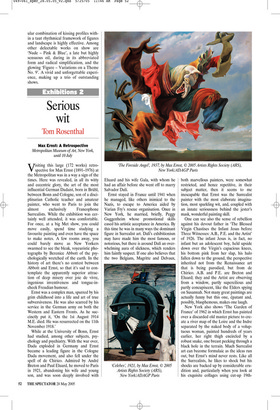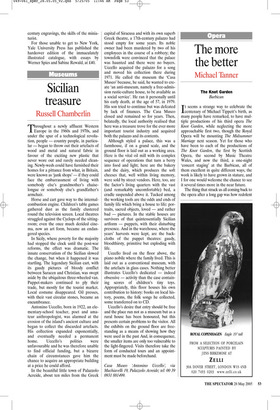Serious wit
Tom Rosenthal
Max Ernst: A Retrospective Metropolitan Museum of Art, New York, until 10 July Visiting this large (172 works) retrospective for Max Ernst (1891–1976) at the Metropolitan was in a way a sign of the times. Here was revealed, in all its witty and eccentric glory, the art of the most influential German Dadaist, born in Brühl, between Bonn and Cologne, son of a disciplinarian Catholic teacher and amateur painter, who went to Paris to join the almost exclusively Francophone Surrealists. While the exhibition was certainly well attended, it was comfortable. For once, at a big Met show, you could move easily, spend time studying a favourite painting and even have the space to make notes. A few rooms away, you could barely move as New Yorkers swarmed to see the bleak, voyeuristic photographs by Berenice Abbott of the psychologically wretched of the earth. In the history of art there’s no contest between Abbott and Ernst, so that it’s sad to contemplate the apparently superior attraction of deep misery over joie de vivre, ingenious inventiveness and tongue-incheek Freudian humour.
Ernst was a complex man, spurred by his grim childhood into a life and art of true subversiveness. He was also scarred by his service in the German army on both the Western and Eastern Fronts. As he succinctly put it, ‘On the 1st August 1914 M.E. died. He was resurrected on the 11th November 1918.’ While at the University of Bonn, Ernst had studied, among other subjects, psychology and psychiatry. With the war over, Dada exploded in Germany and Ernst became a leading figure in the Cologne Dada movement, and also fell under the spell of de Chirico. Admired by André Breton and Paul Eluard, he moved to Paris in 1921, abandoning his wife and young son, and was soon deeply involved with Eluard and his wife Gala, with whom he had an affair before she went off to marry Salvador Dalí.
Ernst stayed in France until 1941 when he managed, like others inimical to the Nazis, to escape to America aided by Varian Fry’s rescue organisation. Once in New York, he married, briefly, Peggy Guggenheim whose promotional skills eased his artistic acceptance in America. By this time he was in many ways the dominant figure in Surrealist art. Dalí’s exhibitionism may have made him the most famous, or notorious, but there is around Dalí an overwhelming aura of slickness, which renders him faintly suspect. If one also believes that the two Belgians, Magritte and Delvaux, both marvellous painters, were somewhat restricted, and hence repetitive, in their subject matter, then it seems to me inescapable that Ernst was the Surrealist painter with the most elaborate imagination, most sparkling wit, and, coupled with an innate seriousness behind the jester’s mask, wonderful painting skill.
One can see also the sense of rebellion against his devout father in ‘The Blessed Virgin Chastises the Infant Jesus before Three Witnesses: A.B., P.E. and the Artist’ of 1926. The infant Jesus is, in fact, no infant but an adolescent boy, held upside down over the Virgin’s capacious knees, his bottom pink from her slap, his halo fallen down to the ground, the perspective inherited not from the Renaissance art that is being parodied, but from de Chirico. A.B. and P.E. are Breton and Eluard; they and the Artist are observing from a window, partly supercilious and partly concupiscent, like the Elders spying on Susannah. Not many great paintings are actually funny but this one, épatant and, possibly, blasphemous, makes one laugh.
New York also shows ‘The Garden of France’ of 1962 in which Ernst has painted over a discarded old master picture to create a river map of the Loire and the Indre separated by the naked body of a voluptuous woman, painted hundreds of years earlier, her right thigh encircled by a robust snake, one breast peeking through a black hole in the terrain. Much Surrealist art can become formulaic as the ideas run out, but Ernst’s mind never rests. Like all the Surrealists, he likes to shock but his shocks are backed up by considerable erudition and, particularly when you look at his exquisite collages using cut-up 19th century engravings, the skills of the miniaturist.
For those unable to get to New York, Yale University Press has published the hardcover edition of the immaculately illustrated catalogue, with essays by Werner Spies and Sabine Rewald, at £40.























































 Previous page
Previous page